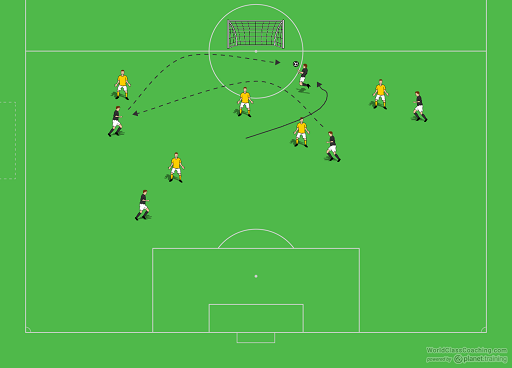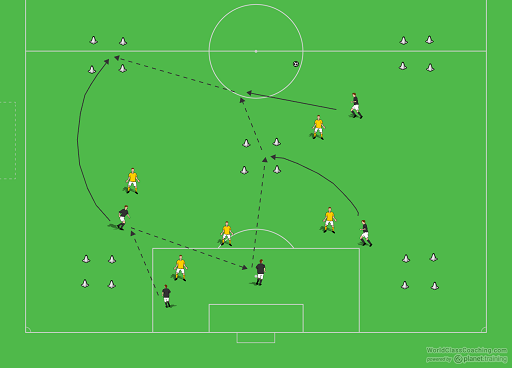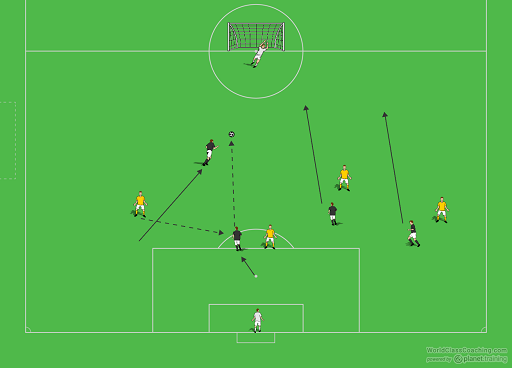By Gregg Gillies -
Warm Up: Hand Ball Soccer
This is a great warm up game. When utilizing it with my teams, I've found that it gets them engaged and excited about the upcoming practice session (their brains are switched “on” and they are focused). It gets their bodies moving and their minds ready for what's next without the mind numbing repetitiveness of typical warm up drills.
You'll find it's a fantastic warm up for one of the biggest challenges many coaches face; taking their players from reacting to anticipating and moving off the ball.
As coaches, we all know how challenging it is to teach good off the ball movement, to get your players to embrace this, instead of getting caught just watching the game when they don't have the ball, and then reacting after the fact.
By not being able to advance the ball except through a pass, players will naturally move off the ball. Also the fact that teammates will better be able to keep the ball and find them in this game, as opposed to doing so with the ball at their feet, will encourage more players to move.
They'll also play the game at a faster speed.
With a number of progressions and rules, it can be quite challenging, help improve technical skills and create variety so it's not the same each time it's used.

Set Up: The length of the field and the number of players can vary greatly depending on the space you have available. It seems to work best in the 4v4 to 7v7 range, on a field of 30x30 to 50x30.
Rules: Teams move the ball by throwing it with their hands. When they catch a ball they can't move. In order to move up the field, you must throw the ball to teammates. If the ball hits the ground on an attempted throw, it belongs to the other team, who can pick it up and attack.
In order to score, you must play a ball with your body, into the goal. This means volleys, headers, even the chest or thigh, whatever works to take the ball out of the air and put it in the goal. Clearly, this works well for working on taking crosses (in this case, throws) out of the air. Many more chances to do so in this warm up game.
Coaching Points: Not many. It's a warm up and the rules will pretty much take care of the objective. As discussed above, the rules and uniqueness of this game will naturally have players moving off the ball, anticipating, and taking balls out of the air (as many youth coaches know, this always presents a challenge when the game starts taking place in the air more often).
Let them play. You'll find this is a game that truly does do the teaching. Make note of anything you want to discuss and talk about it after the warm up or when something similar comes up later in practice.
Progressions: You'll always be able to make this game more (or less challenging). If your players are really young, you can allow them to volley or head the ball our of their own hands intead of off the pass from a teammate. Or make them play a touch off the thigh before volleying.
You can also limit how a team scores.
Goals could come only by:
• A header
• A laces volley
• An inside of the foot volley
• A chest touch then volley
• Pretty much any touch combination you can think of that will challenge and engage your players.
Small Sided Game: Movement X
Set Up: 3v3 (up to 6v6) on a 40x30 field (can be made smaller or bigger depending on your teams age and ability).
Rules: There are 5 squares set up on the field (see diagram below). One near each corner of the field and one in the very middle of the field. The squares are 3 to 5 yards (can be adjusted to increase or decrease the difficulty level of passing). Each team goes toward two squares at the one end (like 2 goals) but both teams can use the center square.
To “score” a goal, a team must successfully pass into one of their end squares or the middle square. However, a player can not wait in the square, they must meet the ball in the square. When they “score” they retain possession and contiue to play.

Like the Hand Ball game warm up, Movement X is designed to get players to focus on and beware of, movement off the ball into space, and anticipating passes, both as the receiver and as the player playing the pass into the square.
Coaching Points: The middle square allows teams to focus on runs through the middle and making passes that switch the field of play. It also encourages maintaining possession by going backwards from one side of the field to the other, as players realize they can “score” this way.
Correct Body Position - Pop the hips open and let the ball run to the back foot. Receive the ball with knees bent, head up and the first touch should be directional to beat the defender.
Lose your mark – don't stand and wait to receive the pass, check to or away first, then to the ball (or away from it) to create space in which to receive the pass.
• Passing and Support Play
• Decision-making – where and when to attack, playing away from pressure
• Technique on the pass – timing, weight and accuracy
• Timing of the runs off the ball
• Communication
Progressions:
• One or two touch on the final pass only (the one into a square)
• Add one or two neutrals to help the offense move the ball
Scrimmage/Small Sided Game: 1v1 Mark Up
Set Up: This game can be done in any numbers from 2v2 up to full sided but best if used in the 3v3 to 7v7 range.
Rules: All normal soccer rules apply except for one change. Every player on a team is matched up individually against a player on the other team. What this means is, there is no help defensively. For example, if Bob and Sean are matched up against one another, only Bob can defend against Steve when Steve has the ball and vice versa. There is no devensive help!

Coaching Points: Offensively, this reinforces the theme of the previous game and the warm up, and that is anticipating and moving off of the ball. When you can only be stopped by one player on the other team, you become very aware of where they are, where the ball is, and where you might go to get free for a pass. Teams will learn that quick speed of play will wreak havoc on a defense.
There is also a very good defensive element built in and that is accountability, especially in terms of tracking back. If you don't track back defensively after an offensive run, your team will pay for it and all your teammates will know whose fault it was. There is no hiding defensively in this game, the way some players do on a big field.
A summary of the coaching points that are applicable to all these games.
Key Coaching Points
• Angles and distances between the Attackers (game realistic)
• Movements to create triangles and passing options
• Quality, weight and decision of the pass (play around, through or possess)
• Movement to receive
• Body shape to receive
• Angles and distances to combine
• Timing of passes
• Passing options around and ahead of the ball
• Communication
This session will help players to think ahead, anticipate what comes next and encourage them to move off of the ball, instead of just watching it.
By Gregg Gillies
Gregg Gillies is a nationally licensed coach through the USSF and is a Youth Athlete Development Specialist and Head Coach at Mount Laurel United Soccer Club, where he currently coaches a u14 girls team, the MLU Raptors. He also is the owner of www.NoLimitsSoccerTraining.com, where his focus is on maximizing a player's individual technical skills, soccer IQ, and overall athletic development.


